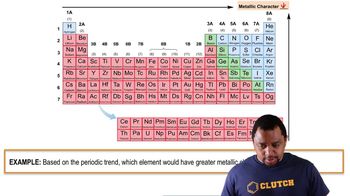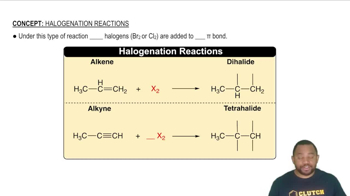For each element, predict where the 'jump' occurs for successive ionization energies. (For example, does the jump occur between the first and second ionization energies, the second and third, or the third and fourth?) a. Be b. N c. O d. Li
Ch.9 - Periodic Properties of the Elements

Chapter 9, Problem 79
Choose the more metallic element from each pair. c. Cl or O
 Verified step by step guidance
Verified step by step guidance1
Step 1: Understand the concept of metallic character. Metallic character refers to how easily an element can lose electrons to form positive ions (cations). Elements with higher metallic character are typically found on the left side and towards the bottom of the periodic table.
Step 2: Locate the elements on the periodic table. Chlorine (Cl) is in Group 17 (halogens) and Period 3, while Oxygen (O) is in Group 16 and Period 2.
Step 3: Compare their positions. Metallic character decreases across a period from left to right and increases down a group. Since both Cl and O are nonmetals, we need to determine which is less nonmetallic (or more metallic) based on their positions.
Step 4: Analyze the trend. Oxygen is higher up in the periodic table compared to chlorine, which means it is less metallic. Chlorine, being lower in the same group, is more metallic than oxygen.
Step 5: Conclude which element is more metallic. Based on their positions and the trend of metallic character, chlorine (Cl) is more metallic than oxygen (O).

Verified video answer for a similar problem:
This video solution was recommended by our tutors as helpful for the problem above.
Video duration:
1mWas this helpful?
Key Concepts
Here are the essential concepts you must grasp in order to answer the question correctly.
Metallic Character
Metallic character refers to the tendency of an element to lose electrons and form positive ions. Elements with high metallic character are typically good conductors of heat and electricity, and they exhibit properties such as malleability and ductility. As you move down a group in the periodic table, metallic character increases, while it generally decreases across a period from left to right.
Recommended video:
Guided course

Metallic Character Example
Periodic Trends
Periodic trends are patterns observed in the properties of elements as you move across or down the periodic table. Key trends include atomic radius, ionization energy, electronegativity, and metallic character. Understanding these trends helps predict the behavior of elements in chemical reactions and their relative positions in terms of reactivity and bonding.
Recommended video:
Guided course

Periodic Trends
Halogens vs. Chalcogens
Halogens (Group 17) and chalcogens (Group 16) are two groups of nonmetals in the periodic table. Halogens, such as chlorine (Cl), are more reactive and have higher electronegativities compared to chalcogens like oxygen (O). While both groups are nonmetals, halogens are generally considered to have less metallic character than chalcogens, making it essential to compare their properties when determining metallic character.
Recommended video:
Guided course

Halogenation Reactions
Related Practice
Textbook Question
Textbook Question
Consider this set of ionization energies. IE1 = 578 kJ/mol IE2 = 1820 kJ/mol IE3 = 2750 kJ/mol IE4 = 11,600 kJ/mol To which third-period element do these ionization values belong?
2
views
Textbook Question
Choose the element with the more negative (more exothermic) electron affinity from each pair. a. Na or Rb
Textbook Question
Choose the more metallic element from each pair. a. Sb or Pb b. K or Ge c. Ge or Sb d. As or Sn
Textbook Question
Arrange these elements in order of increasing metallic character: Fr, Sb, In, S, Ba, Se.
Textbook Question
Arrange these elements in order of decreasing metallic character: Sr, N, Si, P, Ga, Al.
